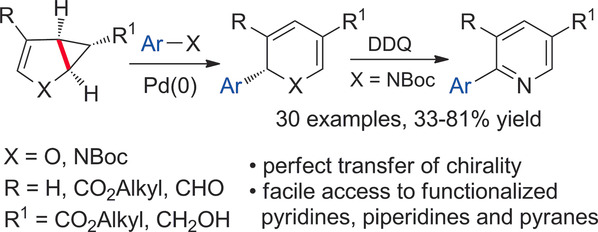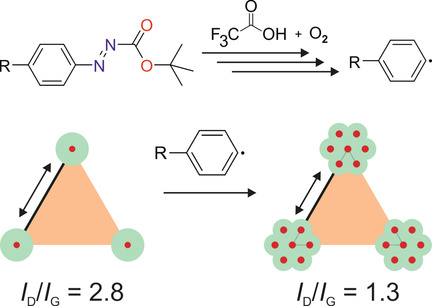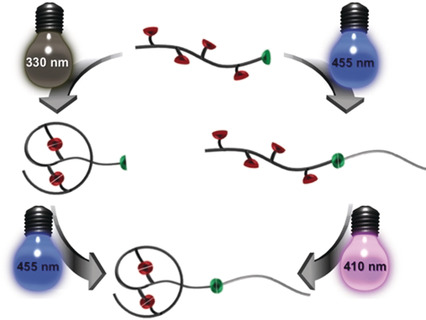Journal list menu
Export Citations
Download PDFs
Cover Pictures
Cover Picture: Oxidative Addition to Palladium(0) Made Easy through Photoexcited-State Metal Catalysis: Experiment and Computation (Angew. Chem. Int. Ed. 11/2019)
- Page: 3229
- First Published: 24 January 2019
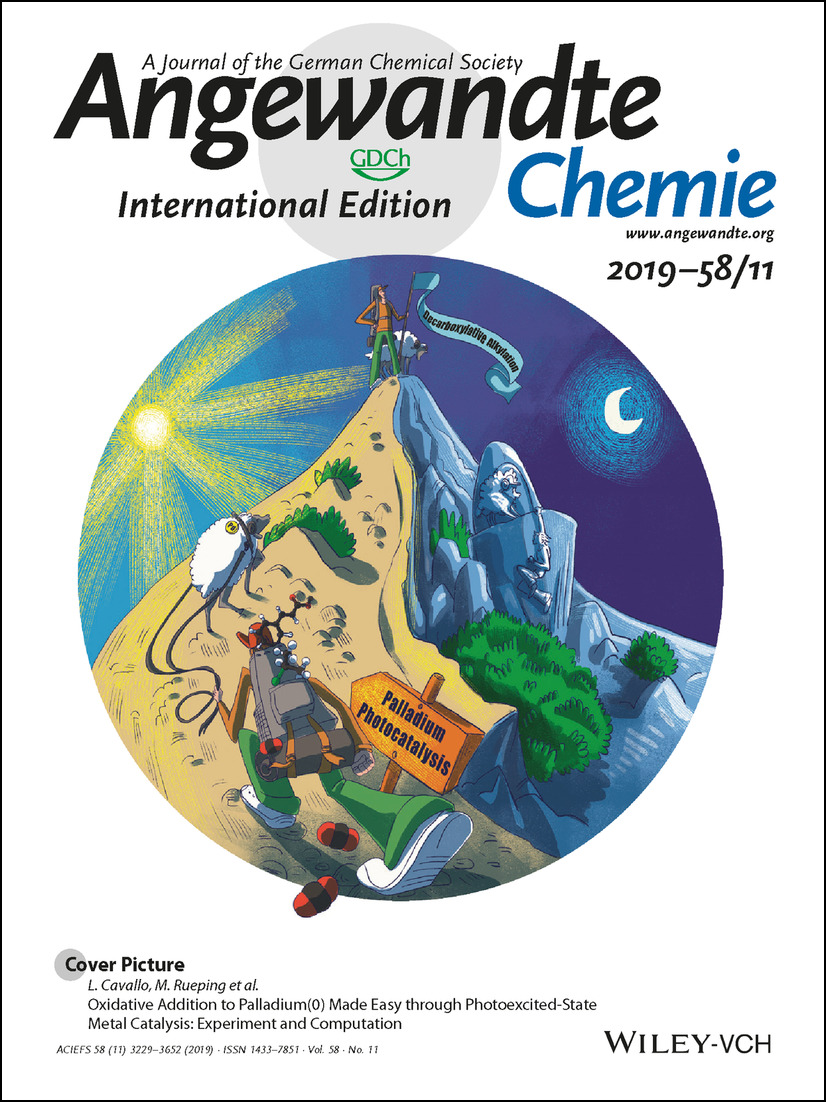
Excited-state palladium catalysis for the stereoselective decarboxylative alkylation of α,β-unsaturated acids is described by M. Rueping, L. Cavallo et al. in their Communication on page 3412 ff. Oxidative addition of alkyl bromide to ground state Pd0 is an energy-demanding, high-barrier process; hence, the reaction cannot proceed in the absence of light (dark side of the image). However, Pd0 in its triplet state, generated by visible light can easily react with the alkyl bromide through a barrierless single-electron transfer leading to decarboxylative alkylation (image in sunlight).
Inside Cover: Aromatic Charge Resonance Interaction Probed by Infrared Spectroscopy (Angew. Chem. Int. Ed. 11/2019)
- Page: 3230
- First Published: 21 January 2019
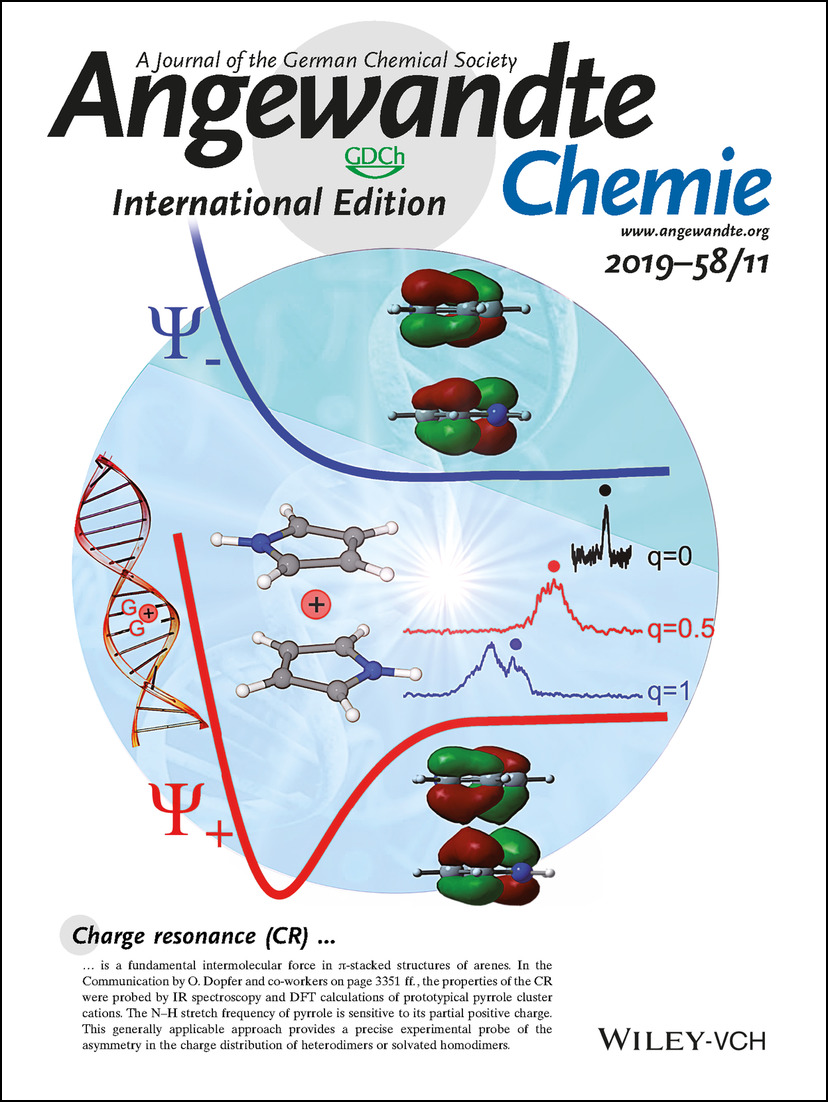
Charge resonance (CR) is a fundamental intermolecular force in π-stacked structures of arenes. In the Communication by O. Dopfer and co-workers on page 3351 ff., the properties of the CR were probed by IR spectroscopy and DFT calculations of prototypical pyrrole cluster cations. The N–H stretch frequency of pyrrole is sensitive to its partial positive charge. This generally applicable approach provides a precise experimental probe of the asymmetry in the charge distribution of heterodimers or solvated homodimers.
Inside Back Cover: Potential-Induced Fine-Tuning of the Enantioaffinity of Chiral Metal Phases (Angew. Chem. Int. Ed. 11/2019)
- Page: 3651
- First Published: 24 January 2019
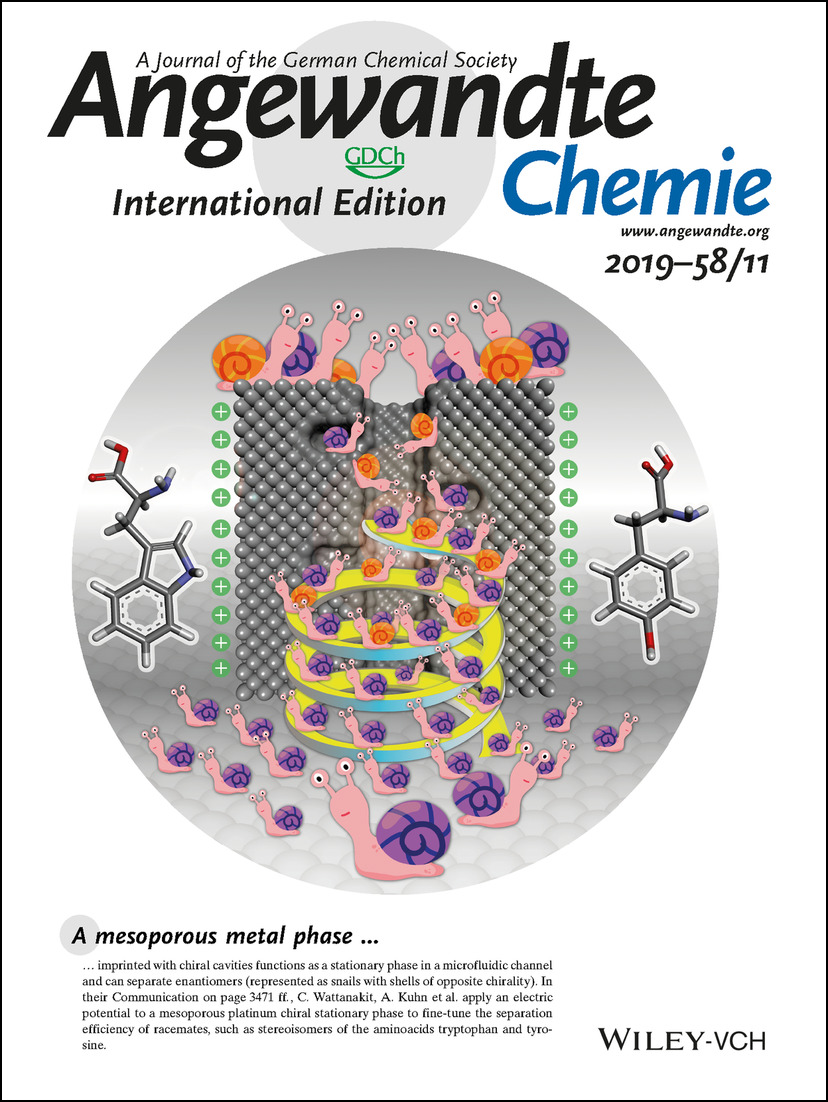
A mesoporous metal phase imprinted with chiral cavities functions as a stationary phase in a microfluidic channel and can separate enantiomers (represented as snails with shells of opposite chirality). In their Communication on page 3471 ff., C. Wattanakit, A. Kuhn et al. apply an electric potential to a mesoporous platinum chiral stationary phase to fine-tune the separation efficiency of racemates, such as stereoisomers of the aminoacids tryptophan and tyrosine.
Back Cover: 161Dy Time-Domain Synchrotron Mössbauer Spectroscopy for Investigating Single-Molecule Magnets Incorporating Dy Ions (Angew. Chem. Int. Ed. 11/2019)
- Page: 3652
- First Published: 18 January 2019
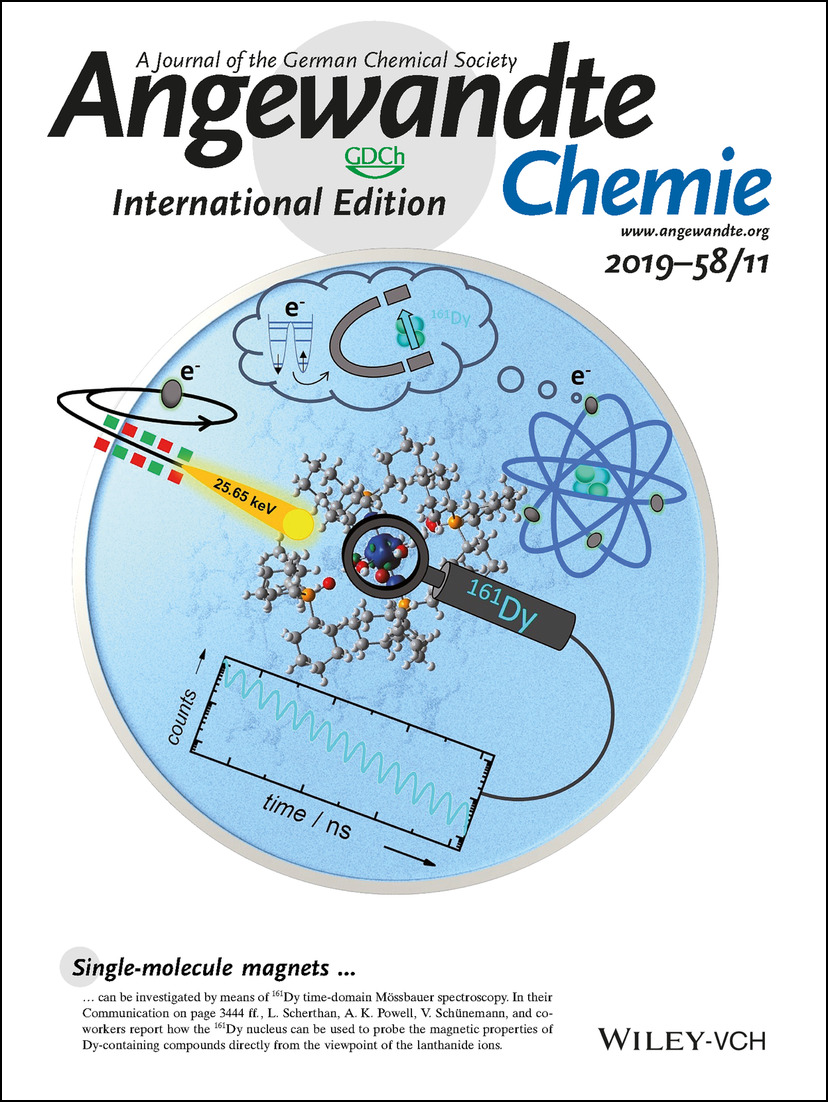
Single-molecule magnets can be investigated by means of 161Dy time-domain Mössbauer spectroscopy. In their Communication on page 3444 ff., L. Scherthan, A. K. Powell, V. Schünemann, and co-workers report how the 161Dy nucleus can be used to probe the magnetic properties of Dy-containing compounds directly from the viewpoint of the lanthanide ions.
Frontispiece
Frontispiece: A Synthetic Polyester from Plant Oil Feedstock by Functionalizing Polymerization
- First Published: 04 March 2019
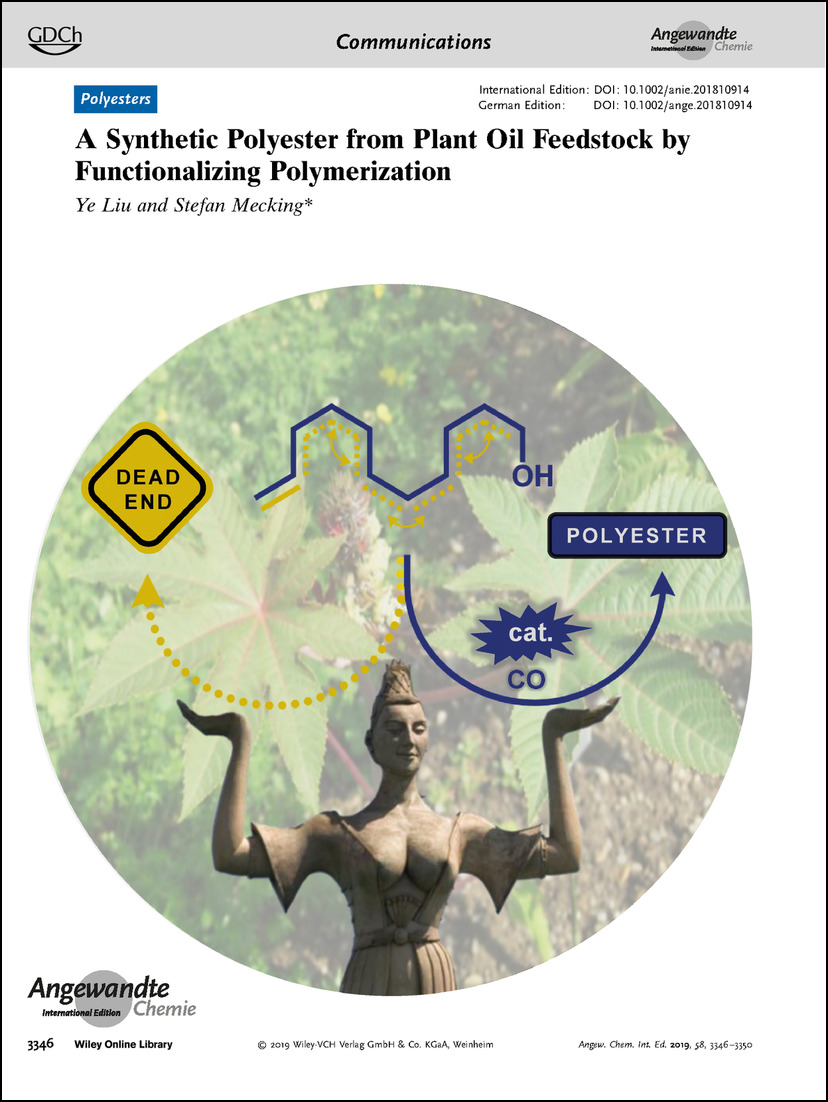
Polyesters S. Mecking and co-workers describe a single-step catalytic functionalization/polymerization of castor-oil-derived undecenol to yield an aliphatic polyester in their Communication on page 3346.
Guest Editorial
Science And Society—What Do They Owe Each Other?
- Pages: 3232-3234
- First Published: 14 January 2019

“Scientists owe it to society to provide guidance, leadership, and above all, moral stature, so that they become role models… Both knowledge and wealth are acquired only through the pursuit of truth. This is smoothly achieved when then there is a seamless exchange of unspoken thought between science and society. …” Read more in the Guest Editorial by G. R. Desiraju.
Graphical Abstract
Graphical Abstract: Angew. Chem. Int. Ed. 11/2019
- Pages: 3236-3253
- First Published: 04 March 2019
News
Spotlights on our sister journals: Angew. Chem. Int. Ed. 11/2019
- Pages: 3256-3260
- First Published: 04 March 2019
Author Profile
News
KNCV Gold Medal: Pascal Jonkheijm / Werner Prize: J. Luterbacher / Grammaticakis-Neumann Award: D. Sarlah
- Page: 3263
- First Published: 01 February 2019
Highlights
Organocatalysis
Acetaldehyde Silyl Enol Ethers in Enantioselective Mukaiyama Aldol Reactions: Enzyme-Like Organocatalysis in Action
- Pages: 3264-3266
- First Published: 07 February 2019
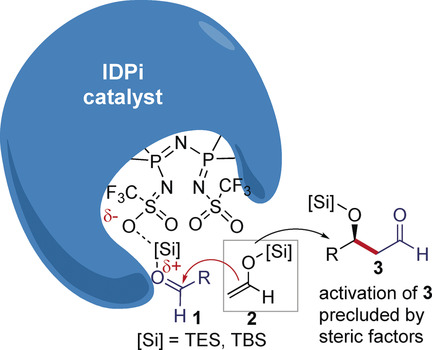
Touched for the very first time! It is herein highlighted how acetaldehyde silyl enol ethers undergo enantioselective Mukaiyama aldol reaction with aliphatic and aromatic aldehydes. The chemistry relies on the use of the highly efficient and substrate-selective imidodiphosphorimidate catalyst, which displays some of the features of enzymatic catalysis.
Minireviews
Boron Chemistry
A New Perspective on Borane Chemistry: The Nucleophilicity of the B−H Bonding Pair Electrons
- Pages: 3268-3278
- First Published: 23 October 2018
Electrochemistry
The Thermodynamics of Insertion Electrochemical Electrodes—A Team Play of Electrons and Ions across Two Separate Interfaces
- Pages: 3279-3284
- First Published: 11 October 2018
Mechanochemistry
Mechanochemistry of Gaseous Reactants
- Pages: 3285-3299
- First Published: 12 November 2018
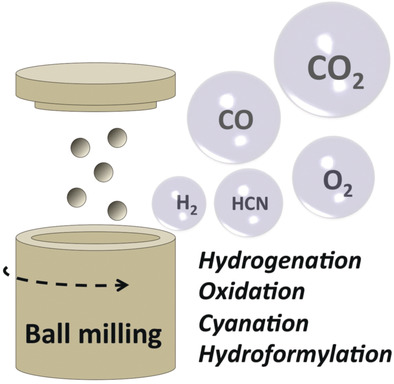
Keep all the balls in the air: This Minireview presents recent examples in the area of mechanochemistry, in which the exertion of mechanical forces by ball milling has enabled chemical transformations with gaseous reactants, together with the technological advances that facilitated such developments.
Reviews
Drug Discovery
A Structural View on Medicinal Chemistry Strategies against Drug Resistance
- Pages: 3300-3345
- First Published: 30 May 2018
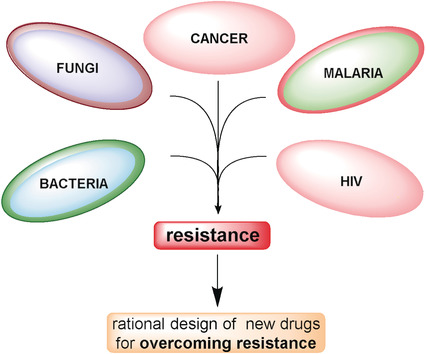
Resistance is futile: The emergence of drug resistance has far-reaching consequences for clinical efficacy. This Review presents an analysis of the underlying structural mechanisms of drug resistance across different therapeutic indications and highlights rational approaches to overcome this threat to public health.
Communications
Polyesters
A Synthetic Polyester from Plant Oil Feedstock by Functionalizing Polymerization
- Pages: 3346-3350
- First Published: 27 November 2018

Catalytic functionalization/polymerization of castor oil-derived undecenol yields an aliphatic polyester in a single step under mild conditions. The key to selective formation of linear high melting polyesters is highly active carbonylation catalysts that at the same time do not undergo strong isomerization.
IR Spectroscopy
Aromatic Charge Resonance Interaction Probed by Infrared Spectroscopy
- Pages: 3351-3355
- First Published: 26 November 2018
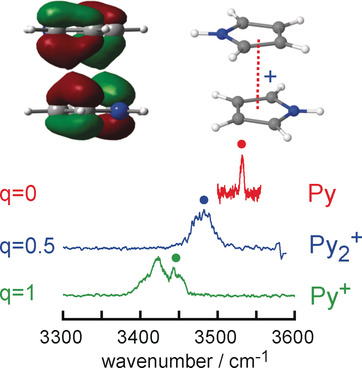
The charge distribution in π-stacked arene dimer cations is probed by infrared spectroscopy of pyrrole clusters. The linear correlation between the N−H stretch frequency and the positive partial charge on the pyrrole moiety (Py) is exploited to reveal subtle effects in the asymmetry of the charge distribution in the charge resonance interaction by symmetry reduction, induced either by substitution of functional groups or by solvation.
UV/Vis Spectroscopy
Optical Spectroscopy of the Au4+ Cluster: The Resolved Vibronic Structure Indicates an Unexpected Isomer
- Pages: 3356-3360
- First Published: 02 January 2019

Y not rhombic? The highly improved optical spectrum of Au4+ with resolved vibrational structure allows the determination of the structure of the cluster in the ground and excited states. In contradiction to all earlier assignments, the lowest-lying observable optical transition does not originate from the rhombic isomer considered most stable but from the Y isomer.
Asymmetric Catalysis
Catalytic Asymmetric Epoxidation of Aldehydes with Two VANOL-Derived Chiral Borate Catalysts
- Pages: 3361-3367
- First Published: 17 December 2018
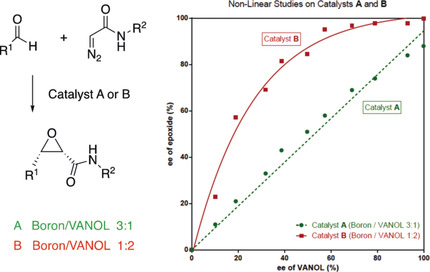
A tale of two catalysts: Two different borate catalysts for the epoxidation of aldehydes with diazoacetamides can be generated from boron and VANOL (3,3′-diphenyl-2,2′-bi-1-naphthalol). That these catalysts are different is demonstrated by a nonlinear study on the relationship of the enantiopurity of the product epoxide versus that of VANOL. Despite their structural differences, both catalysts display a similar substrate scope profile with excellent asymmetric induction for various aldehydes.
Catalysis
A Multicatalytic Approach to the Hydroaminomethylation of α-Olefins
- Pages: 3368-3372
- First Published: 11 January 2019
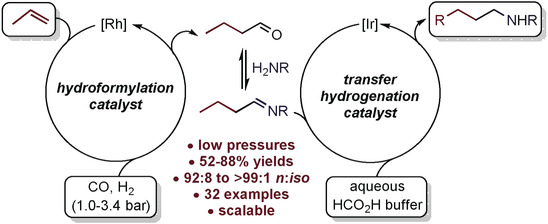
Two cats make HAM: Two distinct, mutually compatible catalysts enable the hydroaminomethylation of alkenes at or near atmospheric pressure of syngas and just 80 °C. The hydroformylation step is catalyzed by a rhodium diphosphine complex, and the reductive amination step, which is conducted as a transfer hydrogenation with aqueous, buffered sodium formate as the reducing agent, is catalyzed by a cyclometallated iridium complex.
Radical Reactions
C−C Bond Formation of Benzyl Alcohols and Alkynes Using a Catalytic Amount of KOtBu: Unusual Regioselectivity through a Radical Mechanism
- Pages: 3373-3377
- First Published: 03 January 2019

Waste not, want not: Benzyl alcohols underwent C−C bond formation with alkynes under thermal conditions in the presence of a catalytic amount of KOtBu to provide α-alkylated ketones with 100 % atom economy (see scheme). The reaction showed unusual regioselectivity to give products in which the C=O group was located on the side of the molecule derived from the alcohol.
Asymmetric Catalysis
Palladium- and Rhodium-Catalyzed Dynamic Kinetic Resolution of Racemic Internal Allenes Towards Chiral Pyrazoles
- Pages: 3378-3381
- First Published: 10 December 2018
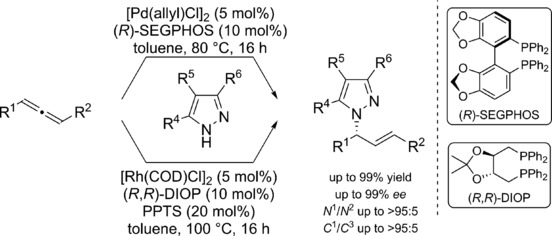
A complementing Pd- and Rh-catalyzed dynamic kinetic resolution (DKR) of racemic allenes leading to N-allylated pyrazoles is described. Such compounds are of enormous interest in medicinal chemistry as drugs and drug candidates. The new methods feature high chemo-, regio- and enantioselectivity displaying a broad substrate scope and functional group compatibility. A mechanistic rational explanation for allene racemization and trans-alkene selectivity is discussed.
Main-Group Compounds
From As-Zincoarsasilene (LZn-As=SiL′) to Arsaethynolato (As≡C−O) and Arsaketenylido (O=C=As) Zinc Complexes
- Pages: 3382-3386
- First Published: 08 January 2019
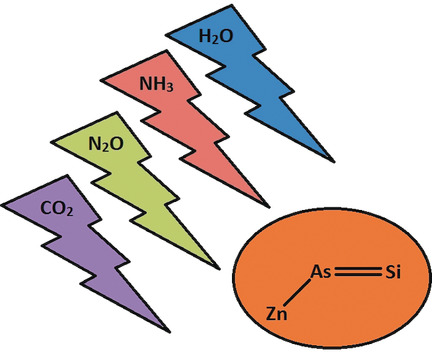
Switch-on functionalities: The peculiar reactivity of an As-zincosilaarsene with H2O, NH3, N2O and CO2 is reported. While the protic reagents add to the As=Si bond to give Si(X)−AsH species (X=OH, NH2), oxidation reactions with N2O and CO2 give rise to the unexpected 1,2-disiloxydiarsene, arsaethynolato siloxido, and arsaketenylido siloxido zinc complexes.
Metal Migration
Asymmetric Alkenylation of Enones and Imines Enabled by A Highly Efficient Aryl to Vinyl 1,4-Rhodium Migration
- Pages: 3387-3391
- First Published: 15 January 2019

The asymmetric rhodium-catalyzed alkenylation of enones and imines with arylboronic acids has been developed. A highly controllable aryl to vinyl 1,4-rhodium migration is the key step. Stereodefined vinyl moieties were installed in excellent enantioselectivies for most examined examples. DFT calculations reveal that the driving force of this rhodium migration is a kinetically favored process.
Metal/Photoredox Catalysis
Regiodivergent Hydroaminoalkylation of Alkynes and Allenes by a Combined Rhodium and Photoredox Catalytic System
- Pages: 3392-3397
- First Published: 08 January 2019

A direct cross-coupling of alkynes and allenes with amines to access α-allylated amines using a Rh/photoredox dual catalyst system was developed. Starting from easily available internal alkynes, tertiary amines, and secondary amines, various branched homoallylic amines were obtained with good to excellent yields and regioselectivity. In contrast, with a modified reaction conditions, the alkynes and terminal allenes could couple with various substituted N-aryl-tetrahydroisoquinolines smoothly affording (E)-linear homoallylic amines in good to excellent yields and regioselectivity.
Solid-State Structures
Rivalry under Pressure: The Coexistence of Ambient-Pressure Motifs and Close-Packing in Silicon Phosphorus Nitride Imide SiP2N4NH
- Pages: 3398-3401
- First Published: 17 January 2019

Under pressure: The silicon phosphorus nitride imide SiP2N4NH was synthesized in a high-pressure high-temperature reaction, using HCl as a mineralizer. Its highly condensed structure is built up from SiN6 octahedra and PN4 tetrahedra and can be derived from a significantly distorted close-packing of nitride anions.
Asymmetric Catalysis
Catalytic Enantioselective Ynamide Additions to Isatins: Concise Access to Oxindole Alkaloids
- Pages: 3402-3406
- First Published: 29 January 2019
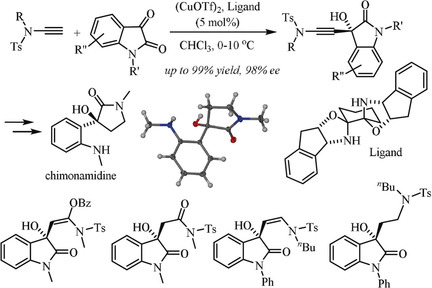
Terminal ynamide additions to isatins are accomplished with high yields and enantioselectivities by base-free CuI-bisoxazolidine catalysis. This approach provides efficient access to chimonamidines and 3-hydroxyindolinones carrying a tetrasubstituted chiral center with a synthetically versatile ynamide moiety.
Asymmetric Synthesis | Hot Paper
Catalytic Asymmetric Synthesis of α-Arylpyrrolidines and Benzo-fused Nitrogen Heterocycles
- Pages: 3407-3411
- First Published: 18 January 2019

An enantioselective copper-catalyzed intramolecular hydroamination reaction can be used jointly with the Suzuki–Miyaura cross-coupling to yield a diverse array of α-arylpyrrolidine scaffolds that contain pharmaceutically relevant heteroarenes with excellent enantiomeric purity under mild conditions. Furthermore, this intramolecular hydroamination strategy is applicable to the asymmetric syntheses of six- to nine-membered benzo-fused nitrogen heterocycles.
Palladium Catalysis
Oxidative Addition to Palladium(0) Made Easy through Photoexcited-State Metal Catalysis: Experiment and Computation
- Pages: 3412-3416
- First Published: 05 December 2018
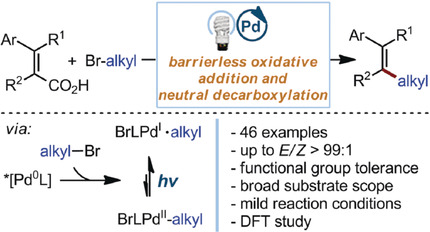
Excited-state palladium catalyzed decarboxylative alkylation of α,β-unsaturated acids is achieved by a barrierless approach under visible light irradiation at room temperature with good stereoselectivity. Detailed DFT calculations with experimental evidence suggest a neutral decarboxylative pathway.
Surface Chemistry
Controlling an SN2 Reaction by Electronic and Vibrational Excitation: Tip-Induced Ether Cleavage on Si(001)
- Pages: 3417-3420
- First Published: 22 January 2019
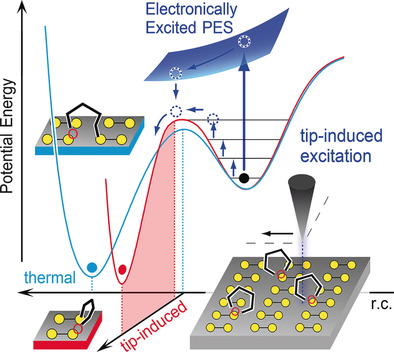
Everything under control: New final products are observed when ether cleavage on Si(001)—the surface analogue of an SN2 reaction—is induced by the electrons of an STM tip. The nature of these final products can be controlled by the excitation mechanism—electronic or vibrational—which in turn can be selectively addressed by the tunneling bias. PES=potential energy surface.
C−H Functionalization
Copper-Catalyzed C(sp3)−H Amidation: Sterically Driven Primary and Secondary C−H Site-Selectivity
- Pages: 3421-3425
- First Published: 24 January 2019
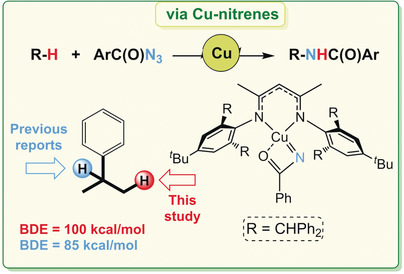
Swimming against the tide: A new β-diketiminate CuI catalyst system has been developed for C−H amidation with aroyl azides via copper nitrene intermediates. Owing to their steric bulk they target stronger, more accessible primary and secondary C−H bonds in the presence of weaker, hindered tertiary C−H bonds.
Electrocatalysis
Evolution of Oxygen–Metal Electron Transfer and Metal Electronic States During Manganese Oxide Catalyzed Water Oxidation Revealed with In Situ Soft X-Ray Spectroscopy
- Pages: 3426-3432
- First Published: 27 December 2018
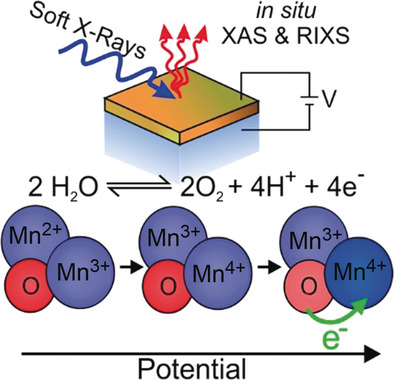
In situ X-ray absorption spectroscopy and resonant inelastic X-ray scattering at the Mn L- and O K-edges are employed to probe an operating MnOx water oxidation catalyst. A critical step of the reaction mechanism, namely withdrawal of electron density from the O ligand shell at positive potentials, is detected and correlated with the rate-determining electron transfer process.
Hydrogen Production
Tailoring the Grain Boundary Chemistry of Polymeric Carbon Nitride for Enhanced Solar Hydrogen Production and CO2 Reduction
- Pages: 3433-3437
- First Published: 16 January 2019

Polymeric carbon nitride with enhanced optical absorption and photocatalytic activities is synthesized via a one-pot ionothermal polymerization of 5-aminotetrazole in eutectic NaCl/KCl. This approach allows control of the polymerization process and tailoring of the grain boundary structure and catalytic properties.
Secondary-Ion Mass Spectrometry | Hot Paper
Boron-Containing Probes for Non-optical High-Resolution Imaging of Biological Samples
- Pages: 3438-3443
- First Published: 07 January 2019
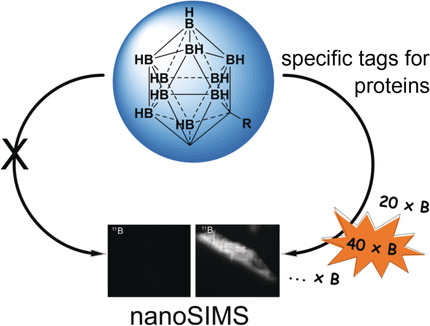
Light on by boron: Tagging cellular proteins with carboranes enables their visualization with non-optical techniques such as nanoSIMS. Flexible protocols for the incorporation of the tags in a specific manner are shown. By combining the synthesis of carborane derivatives with biotechnological tools, high densities of the probes could be obtained inside cells, enabling relatively easy labeling and detection.
Mössbauer Spectroscopy
161Dy Time-Domain Synchrotron Mössbauer Spectroscopy for Investigating Single-Molecule Magnets Incorporating Dy Ions
- Pages: 3444-3449
- First Published: 12 December 2018

A new point of view: The magnetic hyperfine field at the 161Dy nucleus in Dy-containing compounds can be determined by 161Dy time-domain synchrotron Mössbauer spectroscopy. This quantity is influenced by the polarization of the s electrons at the 161Dy nucleus via metal–ligand interactions. The effect of different ligands in Dy-containing single-molecule magnets can now directly be explored from the viewpoint of the lanthanide ion.
Zeolites
Influence of Hydronium Ions in Zeolites on Sorption
- Pages: 3450-3455
- First Published: 02 January 2019
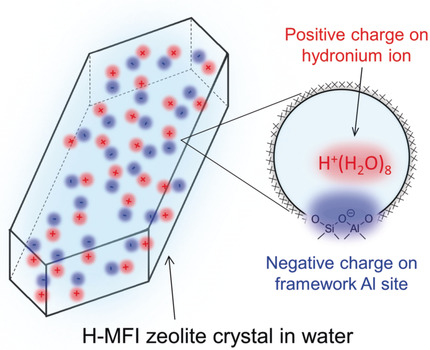
A hydrated hydronium ion in zeolite H-MFI consists of eight water molecules and occupies a volume of 0.24 nm3, which is inaccessible for nonpolar substrates. Hydrated hydronium ions induce locally a high ionic strength resulting in a strongly nonideal environment. This destabilizes the adsorption of substrates, by lowering the heat of adsorption, but increasing the activity coefficient of the substrate.
Heterogeneous Photosensitizers
Hydrophobic Metal Halide Perovskites for Visible-Light Photoredox C−C Bond Cleavage and Dehydrogenation Catalysis
- Pages: 3456-3460
- First Published: 10 January 2019
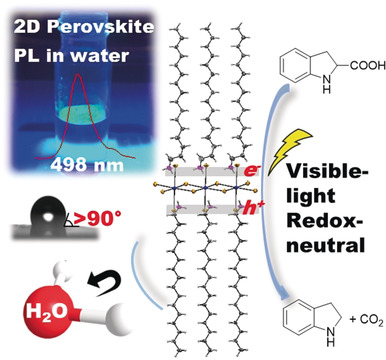
Water repellent and light: Hydrophobic 2D Pb and Sn halide perovskites were synthesized under ambient conditions by solution-based methods and showed contact angles over 90° as well as dispersibility and photoluminescence in water, thus highlighting their hydrophobic behavior. The perovskites were also effective photocatalysts for visible-light-driven redox-neutral decarboxylation and oxidative dehydrogenation reactions.
Antitumor Agents
Intracellular Localization of an Osmocenyl-Tamoxifen Derivative in Breast Cancer Cells Revealed by Synchrotron Radiation X-ray Fluorescence Nanoimaging
- Pages: 3461-3465
- First Published: 20 January 2019
Cluster Compounds
Synthesis and Reactivity of an Early-Transition-Metal Alkynyl Cubane Mn4C4 Cluster
- Pages: 3466-3470
- First Published: 11 January 2019
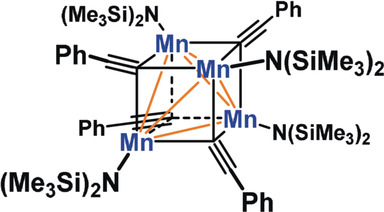
Early days: The first noncoinage-metal alkynyl M4C4 cubane has been prepared and characterized (see structure). The nanocluster contains two sets of MnII environments, which exhibit strong antiferromagnetic coupling. Facile amido ligand exchange and the formation of Mn nanoparticles were evaluated in catalytic studies.
Chiral Discrimination
Potential-Induced Fine-Tuning of the Enantioaffinity of Chiral Metal Phases
- Pages: 3471-3475
- First Published: 15 December 2018
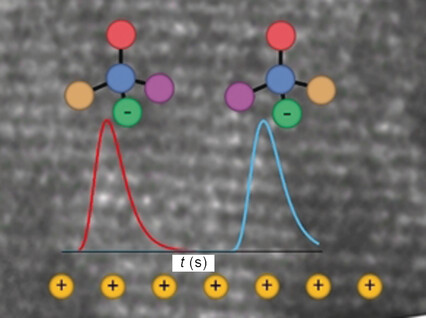
In for a shock: The electric potential of a mesoporous chiral platinum phase can be tuned to allow quantitative separation of the enantiomers in a tryptophan racemate. An applied potential influences the electrostatic interactions, and thereby the enantioaffinity, between the chiral metal and the target enantiomer.
C−H Activation
Late-Stage Diversification through Manganese-Catalyzed C−H Activation: Access to Acyclic, Hybrid, and Stapled Peptides
- Pages: 3476-3480
- First Published: 19 December 2018
Metal–Organic Materials
A Metal–Organic Supramolecular Box as a Universal Reservoir of UV, WL, and NIR Light for Long-Persistent Luminescence
- Pages: 3481-3485
- First Published: 07 January 2019

All paths lead to Rome: By the careful design of a donor–π–acceptor ligand with both one- and two-photon absorption attributes (OPA and TPA), LPL could be triggered in an assembled metal–organic supramolecular box through either OPA or TPA pathways by several wavebands of light: UV, white (WL), and NIR (see picture). Such systems have potential for a range of applications, including anti-counterfeiting, camouflaging, decorating, and displays.
Heterogeneous Catalysis
Nylon Intermediates from Bio-Based Levulinic Acid
- Pages: 3486-3490
- First Published: 16 January 2019

Green nylon: Use of 25 % ZrO2/SiO2 as catalyst allows the gas-phase ring-opening of bio-based γ-valerolactone with methanol to a mixture of methyl pentenoates containing 81 % of the 4-isomer, which could be selectively hydroformylated from the mixture to methyl 5-formyl-valerate, an intermediate for ϵ-caprolactam. The remaining isomers were converted into dimethyl adipate.
Cobalt Electrocatalysts
Highly Active Cobalt-Based Electrocatalysts with Facile Incorporation of Dopants for the Oxygen Evolution Reaction
- Pages: 3491-3495
- First Published: 21 January 2019
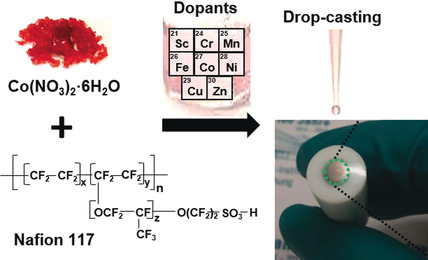
Simplest is best: Electroactive cobalt species for the oxygen evolution reaction can be prepared simply by applying an anodic bias to a mixture of a commercially available cobalt precursor and Nafion binder coated on a glassy carbon electrode. Iron dopants effectively activate the cobalt species, and most of the first row transition metals could also enhance the catalytic performance.
Supramolecular Chemistry
Accordion-Like Motion in Electrochemically Switchable Crown Ether/Ammonium Oligorotaxanes
- Pages: 3496-3500
- First Published: 08 January 2019
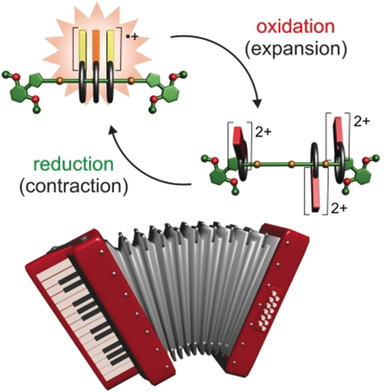
Play that squeezebox! Reversible switching of electrochemically controllable oligorotaxanes generates an accordion-like molecular movement. Electrochemistry, EPR, and UV/Vis-NIR studies reveal that this type of motion is induced by through-space mixed-valence, radical-cation, and Coulombic interactions between tetrathiafulvalene-decorated crown ether macrocycles.
Bimetallic Catalysis
RhIAr/AuIAr′ Transmetalation: A Case of Group Exchange Pivoting on the Formation of M−M′ Bonds through Oxidative Insertion
- Pages: 3501-3505
- First Published: 02 January 2019
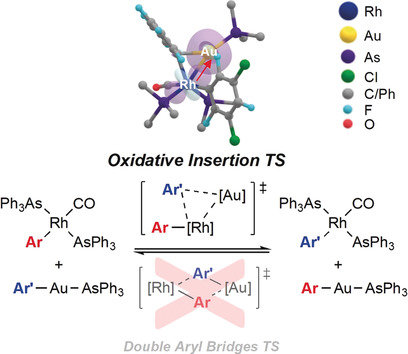
Transmetalation, but not as you know it: A combination of kinetic studies, theoretical calculations, and microkinetic modeling showed that C6F5 (Pf)/C6Cl2F3 (Rf) exchange between [AuPf(AsPh3)] and trans-[RhRf(CO)(AsPh3)2] does not occur by typical concerted Pf/Rf transmetalation via electron-deficient double bridges. Instead, nucleophilic attack of RhI at the gold center triggers asymmetric oxidative insertion of Rh into the Au−aryl bond (see scheme).
Enzyme Catalysis
The Bacterial [Fe]-Hydrogenase Paralog HmdII Uses Tetrahydrofolate Derivatives as Substrates
- Pages: 3506-3510
- First Published: 02 January 2019
![The Bacterial [Fe]-Hydrogenase Paralog HmdII Uses Tetrahydrofolate Derivatives as Substrates](/cms/asset/1113fe91-e0b9-495d-894a-213239792adf/anie201813465-toc-0001-m.jpg)
[Fe]-hydrogenase (Hmd) catalyzes the hydrogenation of methenyl-tetrahydromethanopterin (methenyl-H4MPT+). H4MPT is a C1-carrier of methanogenic archaea. One bacterial genus contains the Hmd paralog, HmdII. Bacterial HmdII catalyzes the hydrogenation of derivatives of the bacterial C1-carrier, tetrahydrofolate. The crystal structure of HmdII explains the evolutionary adaptation to the different hydride-accepting substrate.
Metal–Organic Frameworks | Very Important Paper
Metal–Organic-Framework-Derived Hollow N-Doped Porous Carbon with Ultrahigh Concentrations of Single Zn Atoms for Efficient Carbon Dioxide Conversion
- Pages: 3511-3515
- First Published: 19 December 2018
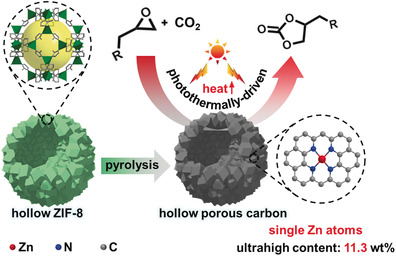
Hollow porous carbons (HPC), featuring hierarchical pores and uniform dopants of nitrogen and ultrahigh content (11.3 wt %) of single-atom Zn, are fabricated by the pyrolysis of template-directed hollow ZIF-8 spheres. Thanks to the Zn/N sites and the photothermal effect endowed by those features, the optimized HPC-800 efficiently catalyzes CO2 cycloaddition with epoxides under light irradiation at ambient temperature.
Supramolecular Chemistry
A Water-Soluble Perylene Bisimide Cyclophane as a Molecular Probe for the Recognition of Aromatic Alkaloids
- Pages: 3516-3520
- First Published: 21 December 2018
Lithium Ion Batteries
Approaching the Lithiation Limit of MoS2 While Maintaining Its Layered Crystalline Structure to Improve Lithium Storage
- Pages: 3521-3526
- First Published: 09 January 2019

By fine-tuning the lithiation depth of MoS2, the layered crystalline structure can be well preserved when cycled (3.0–0.6 V vs. Li+/Li), which is accompanied with the expansion of the interlayer distance. These features enable the stable cycling of commercial μm-sized MoS2 with higher capacity and faster rate capability, making it a promising anode for fast-charging lithium ion batteries.
Surface Chemistry
The Nature of Hydrogen Adsorption on Platinum in the Aqueous Phase
- Pages: 3527-3532
- First Published: 17 December 2018
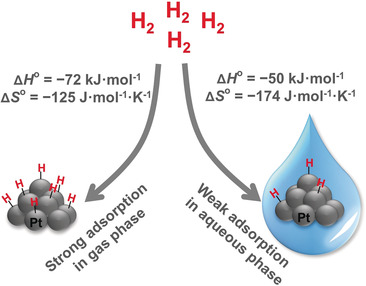
The thermodynamic state of H2 adsorbed on Pt in the aqueous phase was determined via kinetic analysis of H2 reacting with D2O and by DFT-based ab initio molecular dynamics simulations of H2 adsorption on Pt(111). Compared to the gas–solid interface, the presence of liquid water weakens the dissociative adsorption by decreasing the heat of adsorption and inducing a larger loss of entropy.
Bioconjugation
STEFs: Activated Vinylogous Protein-Reactive Electrophiles
- Pages: 3533-3537
- First Published: 07 January 2019

S marks the spot: A new class of activated vinylogous thioesters, called STEFs, were evaluated for use as biological electrophiles. These compounds, for example, enable cysteine-directed lysine conjugations by consecutive addition–elimination reactions. STEFs, as electrophilic warheads, could find broad use in chemical biology.
Photochemistry
Enantioselective Visible-Light-Mediated Formation of 3-Cyclopropylquinolones by Triplet-Sensitized Deracemization
- Pages: 3538-3541
- First Published: 15 January 2019

Mirror mirror on the wall, where has the other enantiomer gone? Catalyst 2 establishes an equilibrium between the two enantiomers 1 and ent-1 in which one enantiomer prevails (up to 55 % ee). The deracemization is responsible for the enantioselective formation of 3-cyclopropylquinolones from 3-allyl-substituted quinolones.
Bioconjugation
Efficient Pictet–Spengler Bioconjugation with N-Substituted Pyrrolyl Alanine Derivatives
- Pages: 3542-3547
- First Published: 17 January 2019
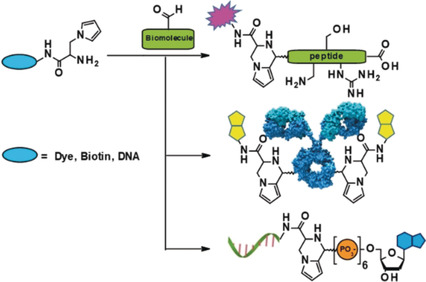
Small but mighty: The atom efficient and easy to synthesize reagent N-pyrrolyl alanine is shown to undergo fast and site-selective Pictet–Spengler bioconjugation. This catalyst-free conjugation strategy was successfully applied for the biocompatible, site-specific, and stable labeling of aldehydes in peptides, antibodies and, nucleic acids.
Anions
Acyl-Phosphide Anions via an Intermediate with Carbene Character: Reactions of K[PtBu2] and CO
- Pages: 3548-3552
- First Published: 16 January 2019
Natural Products
In Vitro Reconstitution of Bacterial DMSP Biosynthesis
- Pages: 3553-3556
- First Published: 04 January 2019

Nature's way: The first complete description of a DMSP biosynthetic pathway is provided by the in vitro reconstitution of four enzymes from Streptomyces mobaraensis. This pathway follows the same route as that previously described for angiosperm plants; however, this study shows that the two biosynthetic activities emerged by convergent evolution.
Catalysis | Very Important Paper
Chiral Heterobimetallic Bismuth–Rhodium Paddlewheel Catalysts: A Conceptually New Approach to Asymmetric Cyclopropanation
- Pages: 3557-3561
- First Published: 23 January 2019
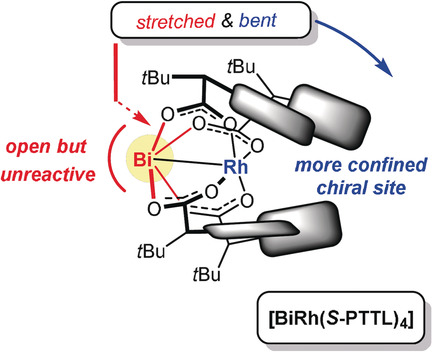
Stretched and Bent: Formal replacement of one Rh atom in a classical dirhodium tetracarboxylate paddlewheel complex by Bi results in a conical shape of the precatalyst: while the wide-open Bi site does not cause a racemic background reaction, the calyx-like chiral binding pocket around Rh is narrower and hence more effective. These two virtues likely synergize in asymmetric cyclopropanation reactions.
Paired Electrochemistry | Hot Paper
Paired Electrochemical Reactions and the On-Site Generation of a Chemical Reagent
- Pages: 3562-3565
- First Published: 31 January 2019
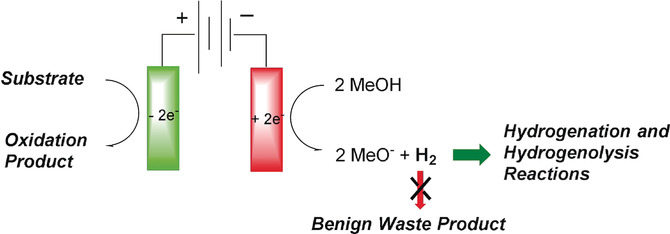
An alcohol oxidation, an oxidative condensation, intramolecular anodic olefin coupling reactions, an amide oxidation, and a mediated oxidation were all shown to be compatible with the generation and use of hydrogen gas at the cathode. This pairing of an electrolysis reaction with the production of a chemical reagent or substrate has the potential to greatly expand the use of more energy efficient paired electrochemical reactions.
Photochemistry
The Dual Role of Benzophenone in Visible-Light/Nickel Photoredox-Catalyzed C−H Arylations: Hydrogen-Atom Transfer and Energy Transfer
- Pages: 3566-3570
- First Published: 18 February 2019

Benzophenone resurrected: The inherent reactivity of benzophenone upon photochemical excitation is used for the aliphatic C−H arylation reaction. The conditions are tolerant to a broad range of functional groups. Mechanistic experiments shed light on the dual role of the new photocatalyst of the metallaphotoredox family.
Asymmetric Catalysis
Enantioconvergent Cross-Couplings of Alkyl Electrophiles: The Catalytic Asymmetric Synthesis of Organosilanes
- Pages: 3571-3574
- First Published: 16 January 2019

Enantioconvergent cross-couplings with electrophiles that lack a directing group or a proximal p/π orbital were achieved for the first time. Specifically, a chiral nickel catalyst can accomplish Negishi reactions of racemic α-halosilanes with alkylzinc reagents with good enantioselectivity under simple and mild conditions, thereby providing access to enantioenriched organosilanes, an important class of target molecules.
Radical Reactions
Enantioselective Construction of α-Chiral Silanes by Nickel-Catalyzed C(sp3)−C(sp3) Cross-Coupling
- Pages: 3575-3578
- First Published: 15 January 2019
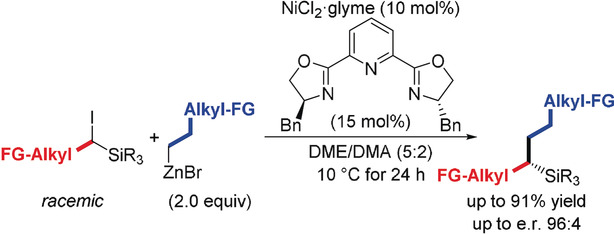
Chiral silicon grease: α-Chiral silanes with no functional group (FG) in direct proximity of the asymmetrically substituted carbon atom are accessible by an enantioselective C(sp3)−C(sp3) cross-coupling of racemic α-silylated alkyl iodides and alkylzinc reagents (see Scheme). The coupling partners can be, but do not need to be, functionalized. α-Chiral silanes can thus be prepared with high modularity.
Hydrocyanation
Transfer Hydrocyanation of α- and α,β-Substituted Styrenes Catalyzed by Boron Lewis Acids
- Pages: 3579-3583
- First Published: 09 January 2019
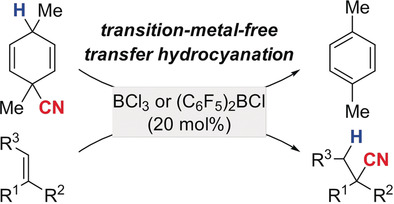
Acid-free! Bench-stable cyclohexa-1,4-diene-based hydrogen cyanide (HCN) surrogates are reported to engage in transfer hydrocyanation of alkenes upon treatment with certain boron Lewis acids. The success also depends on the equilibrium position between the intermediate isocyano- and cyanoborate isomers. Tertiary nitriles are obtained with exclusive Markovnikov selectivity.
Fluorine Chemistry
No Fear of Perfluorinated Peroxides: Syntheses and Solid-State Structures of Surprisingly Inert Perfluoroalkyl Peroxides
- Pages: 3584-3588
- First Published: 21 January 2019
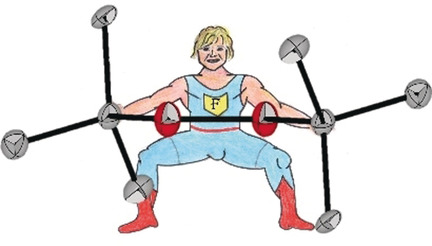
Stretched planar peroxides: [(F3C)3CO]2 and [(C2F5)(F3C)2CO]2 were prepared from the corresponding hypofluorites and fluorinated silver wool. The solid-state structures obtained after in situ crystallisation show unusual COOC dihedral angles of 180° as well as elongated O−O bonds because of the bulky perfluorinated alkyl groups. In addition, they are insensitive to both impact (>40 J) and friction (>360 N).
C−H Annulation
Sulfilimines as Versatile Nitrene Transfer Reagents: Facile Access to Diverse Aza-Heterocycles
- Pages: 3589-3593
- First Published: 02 January 2019
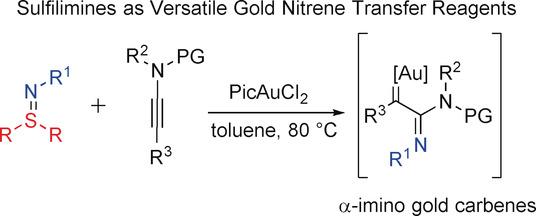
Golden diversity: Readily available sulfilimines were successfully applied as versatile nitrene transfer reagents. By trapping the resulting α-imino gold carbenes with divergent functionalities, four different types of aza-heterocycles (indoles, 3-azabicyclo[3.1.0]hexan-2-imines, quinolines, and imidazoles) were prepared in high efficiency.
Heck Coupling
Regio- and Stereoselective Synthesis of Functionalized Dihydropyridines, Pyridines, and 2H-Pyrans: Heck Coupling of Monocyclopropanated Heterocycles
- Pages: 3594-3598
- First Published: 04 February 2019
Graphene Functionalization | Hot Paper
Selective Functionalization of Graphene at Defect-Activated Sites by Arylazocarboxylic tert-Butyl Esters
- Pages: 3599-3603
- First Published: 20 December 2018
Photochemistry
Controlling Chain Coupling and Single-Chain Ligation by Two Colours of Visible Light
- Pages: 3604-3609
- First Published: 27 December 2018
Liquid Crystals
Fullerene-Filled Liquid-Crystal Stars: A Supramolecular Click Mechanism for the Generation of Tailored Donor–Acceptor Assemblies
- Pages: 3610-3615
- First Published: 07 January 2019
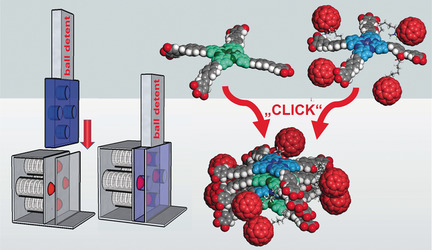
Only a click away: A supramolecular click procedure analogous to a ball detent mechanism (see figure) leads to a helical columnar liquid-crystalline separated donor–acceptor antenna system. Two shape-persistent star mesogens are used: one provides the free space and the other is sterically encumbered by four fullerenes.
Diradicals
Silicon Tris(perchloro)dioxolene: A Neutral Triplet Diradical
- Pages: 3616-3619
- First Published: 10 December 2018
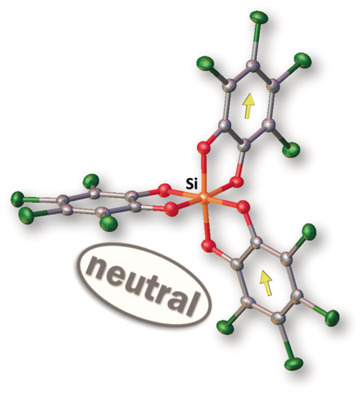
Neutral at last: Silicon tris(perchloro)dioxolene, a neutral diradical with triplet ground state, was obtained by reacting perchloro-o-quinone with silicon tetraiodide. This is the first example of magnetic coupling across hexacoordinate silicon and of a non-metal center that bridges two open-shell semiquinonates.
Adsorption | Very Important Paper
Comparative Adsorption of Acetone on Water and Ice Surfaces
- Pages: 3620-3624
- First Published: 02 January 2019
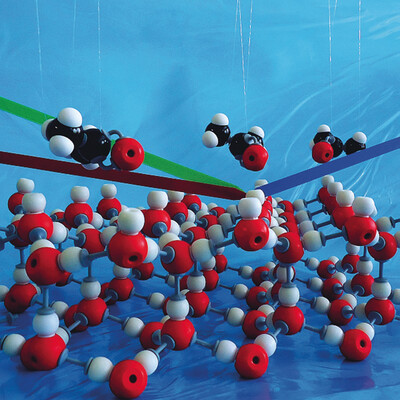
Small organic molecules on ice and water surfaces play crucial roles in many environmentally relevant processes. Surface-specific vibrational spectroscopy was combined with a controllable flow cell apparatus to investigate the molecular adsorption of acetone onto the basal plane of single-crystalline hexagonal ice with a large surface area.
Al–B Redox Chemistry
Aluminum(I)/Boron(III) Redox Reactions
- Pages: 3625-3629
- First Published: 15 January 2019
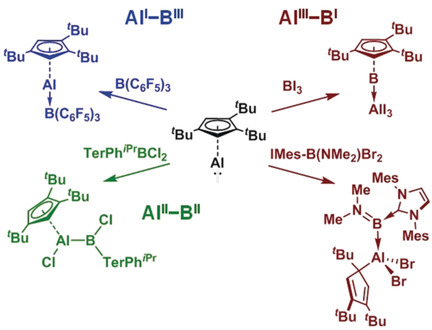
All good things come in threes: Reactions of an AlI nucleophile with BIII species leads to three distinct modes of reactivity: adduct formation (AlI-BIII), oxidative addition (AlII-BII), and reduction (AlIII-BI). IMes=1,3-dimesitylimidazol-2-ylidene, TerPhiPr=bis-2,6-(2,4,6-triisopropylphenyl)phenyl.
C−H Functionalization
Tryptamine Synthesis by Iron Porphyrin Catalyzed C−H Functionalization of Indoles with Diazoacetonitrile
- Pages: 3630-3634
- First Published: 20 December 2018

An iron porphyrin catalyst furnishes acetonitrile-functionalized indole derivatives by C−H functionalization reactions of protected and unprotected indole heterocycles with diazoacetonitrile. This process streamlines the synthesis of valuable tryptamines for applications in total synthesis and drug discovery.
Heterogeneous Catalysis
On the Remarkable Role of the Nitrogen Ligand in the Gas-Phase Redox Reaction of the N2O/CO Couple Catalyzed by [NbN]+
- Pages: 3635-3639
- First Published: 06 January 2019
![On the Remarkable Role of the Nitrogen Ligand in the Gas-Phase Redox Reaction of the N2O/CO Couple Catalyzed by [NbN]+](/cms/asset/d0b7dab6-ca52-4d25-a13f-ea8f10d811c5/anie201814460-toc-0001-m.jpg)
A matter of spin: The [NbN]+/[ONbN]+ system catalyzes the oxidation of CO through N2O. In contrast, in the [Nb]+/[NbO]+ and [NbO]+/[Nb(O)2]+ systems, [Nb]+ and [NbO]+ are oxidized by N2O, even though neither [NbO]+ nor [Nb(O)2]+ react with CO at room temperature. The origins of the distinctly different reactivities are addressed by quantum chemical calculations.
Chemically Induced Dimerization
Inhibitor-Induced Dimerization of an Essential Oxidoreductase from African Trypanosomes
- Pages: 3640-3644
- First Published: 03 January 2019
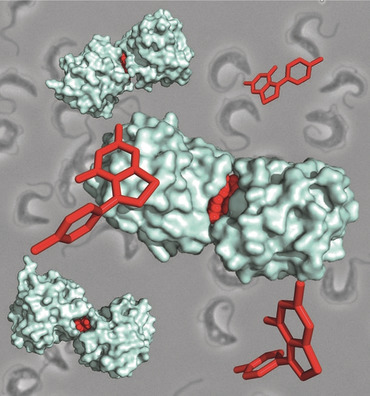
Small but effective: Chemically induced dimerization usually requires large, bifunctional molecules. A small, covalent, monovalent inhibitor efficiently induces dimerization of an essential oxidoreductase from the parasite Trypanosoma brucei, the agent causing African Sleeping Sickness, through elaborate intra- and intermolecular interactions.
Self-Assembly
Positively Charged Nanoaggregates Based on Zwitterionic Pillar[5]arene that Combat Planktonic Bacteria and Disrupt Biofilms
- Pages: 3645-3649
- First Published: 07 January 2019
![Positively Charged Nanoaggregates Based on Zwitterionic Pillar[5]arene that Combat Planktonic Bacteria and Disrupt Biofilms](/cms/asset/306cabf2-fd36-45a1-9c73-dd6f911ffa96/anie201810314-toc-0001-m.jpg)
Biofilm star: A multifunctional zwitterionic pillar[5]arene shows antibacterial ability against Gram-negative Escherichia coli (DH5α) and Gram-positive Staphylococcus aureus (SH1000) bacterial strains in solution. It also showed activity towards established biofilms and killed the biofilm-enclosed cells without rapid generation of resistance.





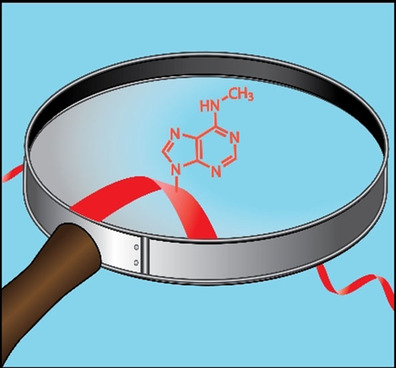

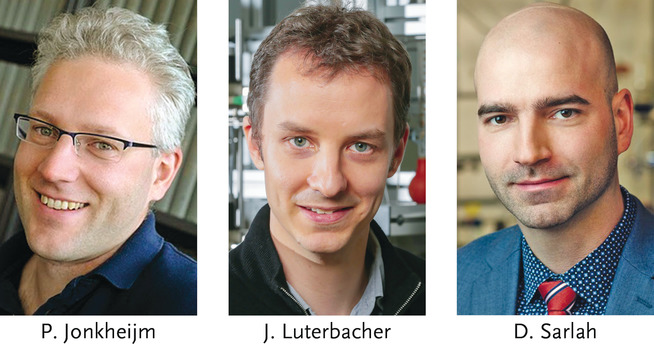
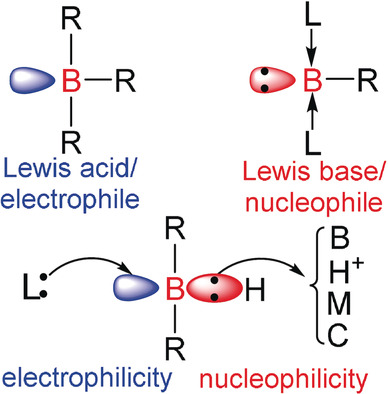
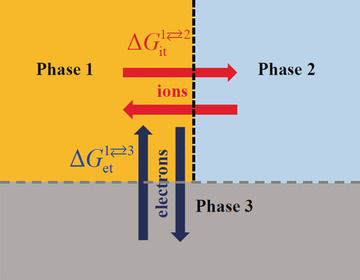
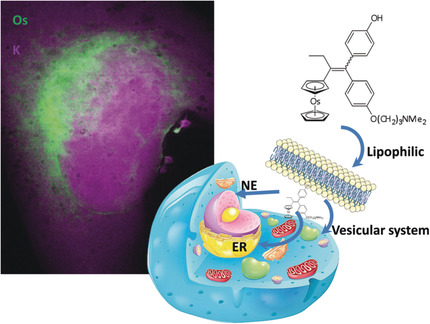

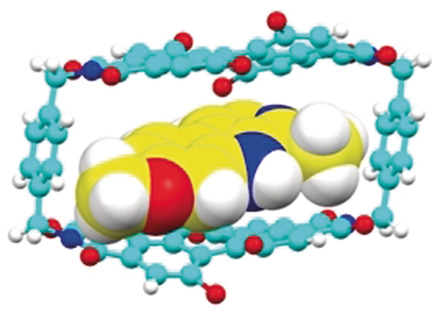
![Acyl-Phosphide Anions via an Intermediate with Carbene Character: Reactions of K[PtBu2] and CO](/cms/asset/de80c700-fba9-4a55-9c05-3e25d54464a1/anie201814562-toc-0001-m.jpg)
